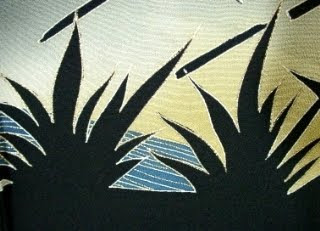Landscape has been a major influence on the decoration of Japanese kimono and obi since the introduction of techniques like yuzen (rice paste resist) dyeing in the late seventeenth century. The mountains, forests and towns are similar to the landscape around Llangollen. Let landscape on kimono freshen your ideas on how to interpret the landscape closer to home.
All the kimono and obi shown are women’s, ranging from formal tomesode (five crested) and furisode (flutter sleeve) kimono to more casual komon (small pattern).
-->
Mountains and Mist

(left above) Furisode (young woman’s long sleeved formal kimono) karinui (tacked kimono fabric), silk rinzu (damask), 1970s.
Traditional abstract mountain design in yuzen (rice paste resist dye). Some mountains have gold stencilled yosōku designs (ancient patterns of the Heian Court

This karinui still has its original price ticket - a mere 250,000 Yen. That would have been £1000 when I worked in Japan (1991 - 92) but over £1600 on today's exchange rates. Luckily the blue dyed areas of the design have got yellowed dots of patina all over them (very tiny and hard to see) which meant the price had dropped to a really tiny fraction of the original when I bought it.
Some of the mountains on the left front are outlined with kinkoma (gold couching).

-->

Houmongi (visiting wear), silk rinzu (damask), contemporary
Pine trees on mountainous islands among mist, clouds and waves, yuzen (rice paste resist dye). Mist is traditionally represented by stepped horizontal bands. The design may be a stylised reference to Matsushima (pine island), a famous beauty spot.
Although it looks black in some photos, the background colour is definitely a very dark, mottled blue. One for remaking - there is a lot of extra length in the horizontal tucks across the front and back.


-->

Kurotomesode (black formal kimono), chirimen (crepe) silk, c.1960
The exotic foliage design and black silhouettes are typical of the late 1950s and early 1960s. The yuzen (rice paste resist dye).is highlighted with painted gold outlines.
The shading in the yuzen motifs is really beautifully done on this kimono.




Now turn right - my pink hemp/poly blend hitoe is on the table and there is a furisode karinui on the chair.

Kurotomesode (black formal kimono) karinui (tacked kimono fabric), ro (open weave) silk, last quarter of C20th
-->
An autumnal mountain landscape with hand embroidered details and kinkoma (couched gold) accents. Ro weaves for summer often depict autumn motifs – advanced seasonal motifs are a sign of good taste.
I would like to sew this kurotomesode to wear myself, although I'll never have the correct occasion to wear it (closely relative of bride or groom at a Japanese wedding).

-->



Mountain motifs as a continuous pattern. Informal Nagoya


-->
Haori (formal kimono jacket) karinui (tacked fabric), silk, contemporary
A scene of minka (farmhouses) in a rugged landscape, in yuzen (rice paste resist dye). The minimal colours emphasises the rather bleak scene.
This karinui hasn't had the collar cut yet, so I might make it into a non-traditional garment, perhaps a longer coat based on the douchugi (a traditional travelling coat for kimono, which fastens across the front, often with a Chinese style button & loop fastening). I already have enough haori to wear!


Next section coming soon!


1 comment:
I have gone through this blog. I found it very interesting and helpful. Best wishes with your search for good Landscape! I'm glad that you want it for your family; I agree it is important to have. I hope you all do find suitable Landscape Company. Great post
Post a Comment